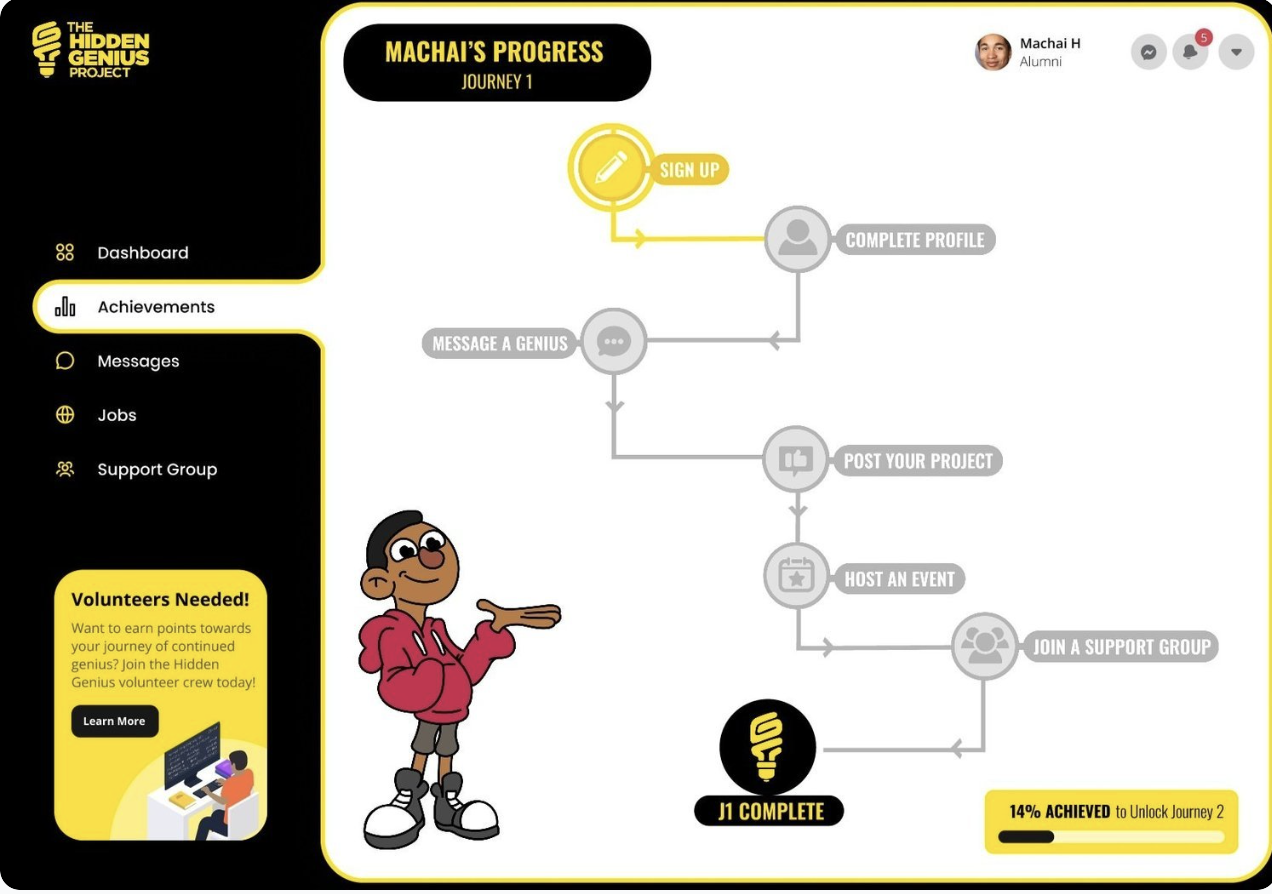Hidden Genius Project
Alumni Platform
Brief
The Hidden Genius Project is a nonprofit that empowers young Black men through mentorship, leadership, and technology training. While the program delivers deep impact during each cohort, alumni often disengage once their time in the program ends. To address this, the goal was to design a digital experience that strengthens long-term connection—giving alumni a reason to return, re-engage, and stay connected to the community.
A redesigned digital platform that fosters ongoing connection, giving alumni clear pathways to stay involved, access resources, and remain part of The Hidden Genius community beyond their cohort.
I partnered with fellow classmates Andre Ford, Brittany Carlson, Gina Yoo, and Tara Hickey to reimagine the digital experience for The Hidden Genius Project. We focused on building a gamified alumni platform that encourages continued engagement through milestones, rewards, and community challenges. I led the design of key interactive features that motivate alumni to stay involved, celebrate their growth, and stay connected to the Hidden Genius mission.
Visualizing Progress, One Step at a Time
This achievement map turns continued engagement into a clear and motivating journey—helping alumni see their growth, unlock new milestones, and celebrate each action they take. By gamifying the experience with a playful path and visual feedback, the platform encourages long-term connection in a way that feels fun, personal, and purpose-driven.
Bridging Opportunity and Community
This jobs board empowers alumni to take the next step in their careers by surfacing tailored opportunities—from tech internships to full-time roles—and showcasing where their peers have landed. It not only supports professional growth but also encourages mentorship and outreach by making employed alumni visible and accessible to those just starting out.
"Out of the people that join, there are only a handful that stay involved. Many people lose touch. It would be nice if they can realize how many more opportunities come if they stay involved"
The long-term role of HGP as a support system isn’t clearly reinforced after graduation.
Alumni aren’t always aware of clear, accessible paths to give back.
Without structured opportunities for continued growth, staying involved can feel undefined or overwhelming.
To keep alumni engaged and prevent drop-off, the platform needed to feel meaningful beyond the program—offering clear ways to grow, give back, and stay connected. I focused on designing an experience that celebrates progress, surfaces relevant opportunities, and makes continued involvement feel easy and rewarding. The goal was to create a space alumni are excited to return to—one that evolves with them and reinforces their place in the Genius community.
Product Development Roadmap
Creating a Hub for Continued Growth and Connection
This dashboard was designed as a centralized space where alumni can track progress, earn achievements, and stay engaged long after their cohort ends. With challenges, events, and a social feed, it encourages ongoing participation and celebrates every step in each Genius’s journey—turning community into motivation and progress into shared celebration.
Fostering Real Connection Beyond the Cohort
This messaging hub creates space for alumni to reconnect, ask questions, and support one another—whether through direct messages or group chats. By bringing conversations into one trusted platform, it helps former participants stay close to the Hidden Genius community and build relationships that continue well beyond their program experience.
Creating Spaces for Belonging and Growth
The support group hub helps alumni find their people—whether through shared interests, career goals, or cohort history. By organizing these groups into easily accessible categories, the platform fosters connection, mentorship, and ongoing collaboration long after the program ends.
The Process
Only 50% continue involvement with program
Lack of motivation due to limited competition
Feeling of isolation due to being limited in resources
Reasons for not continuing
Building a Sustainable Model
Out of 332 million Americans, 5 million Black male youth represent more than just a number—they represent untapped brilliance, innovation, and leadership. The Hidden Genius Project exists to unlock that potential at scale. This isn’t just an opportunity—it’s a responsibility to build a future where every young Black man is empowered to lead, create, and thrive.
Business Model Canvas
This Business Model Canvas outlines the foundational structure for a sustainable alumni platform. By partnering with the alumni network and coordinator, the model centers on increasing engagement, growing the platform, and personalizing the experience for continued value. With 80% of costs allocated to product development and 100% of revenue currently funded through donations and grants, the plan prioritizes mission-driven growth while staying aligned with The Hidden Genius Project’s community-first values.








